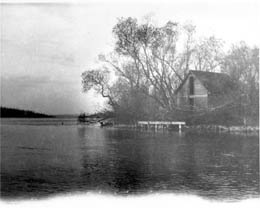This People's History is based on Heather MacIntosh's interview of Homer Venishnick in January 2000, in Renton, Washington. In 1890, Captain Edwin R. Burrows took one look at the idyllic landscape at the head of the Black River and knew immediately, "this was Shangri-La, where my family would live for generations." His great-grandson Homer Venishnick (b. 1926) imagines his great-grandfather's thoughts as he holds a photograph of Captain Burrows house on the Black River, taken around 1900. The family came together on the river over the next several decades, fishing for work and for pleasure.
Homer never knew Captain Burrows. "My grandfather died before I was born, in 1925 .... I was born in '26."
He describes his step-grandfather: "Jack Hayes' wife died in '34. He had a daughter that died of TB [tuberculosis, an infectious disease that usually attacks the lungs], so my grandmother went to housesit for him. They got married. He was the only grandpa I knew."
In the next few years, more family settled in Renton. "Father came out earlier and found this piece of property." Homer points to a 1910 photo of the Burrows Fishing Resort. Renton's Boeing plant now occupies most of this site. "See these weeds out here?" He holds another 1910 photo of Lake Washington perch fishermen who had rented their boat at his father's boat house. "That's where Boeing is now, right down there." He stands up and looks out his dining room window, down to the Boeing Plant, Lake Washington, and acres of development.
Living in the Boat House
"My mother came here when she was two, 102 years ago." Homer holds a picture of his stepfather, mother, and family standing on a Lake Washington dock. The entire family lived in the boat house of the Burrows Fishing Resort.
"This is my stepfather and this is the side of the boat house." He points to a 1910 photo of a stout man wielding a fish on a stick. The boat house stands in the background, a modest wooden building supported by piers.
Living in the boat house got a little harrowing before the lake was lowered in 1916. Homer asks, "You ever heard of the snow of 1910? Can you imagine Lake Washington raising seven feet from the runoff? It raised seven feet, and they lived up in here." (The Cedar River flooded Renton on November 19, 1911, when the Cedar River dam burst 28 miles upstream. These events may be related, or may be the same flood).
"In 1916 they lowered the Lake. It was much bigger back then ..."
When Fishing Season Wasn't Good
"My father, when fishing season wasn't good, when he had to make some money, he'd go to Monohon, where Marymoor Park is now." (Marymoor Park lies on the north end of Lake Sammamish.) "[Monohon] was a mill. There's still some posts out there. There was [also] a mill up in Issaquah."
Homer explains a mill hand's average workday. "You had to get to the steam launch, fire the wood ... cut wood and go to either one of those places [Monohon or the Issaquah mill], and cut some more wood. That was one day's trip. The logs were single logs, they weren't bundled in a truck like they are now."
"He'd go up the next day, he'd come down through the slough, through the length of Lake Sammamish to Bothell, Kenmore, way over, [and] probably cut wood. Then the next day, he'd come home down to the south end of Lake Washington."
"He'd cut wood again, and the next day he'd go out to the Black River and try to get there with the tide ... [as it was] going out the Duwamish so he didn't have to fight the tide going that way. Then he'd come home. It'd take five to seven days for a round trip. [He] probably worked 10 to 12 logging trucks worth. Two trucks could haul the same amount in two days.
"It was hard work back then."

